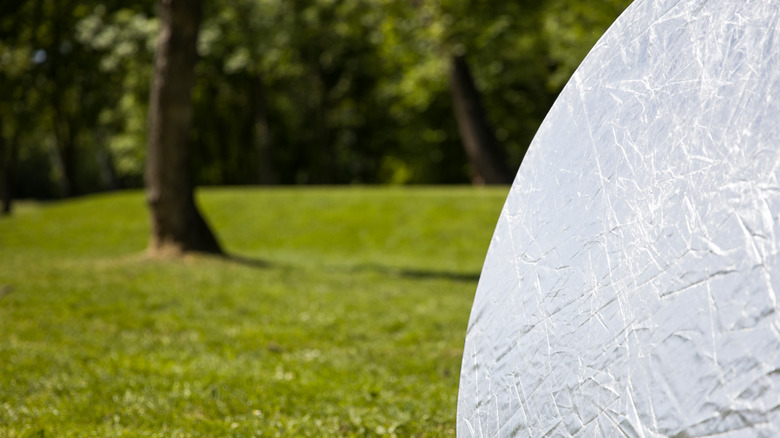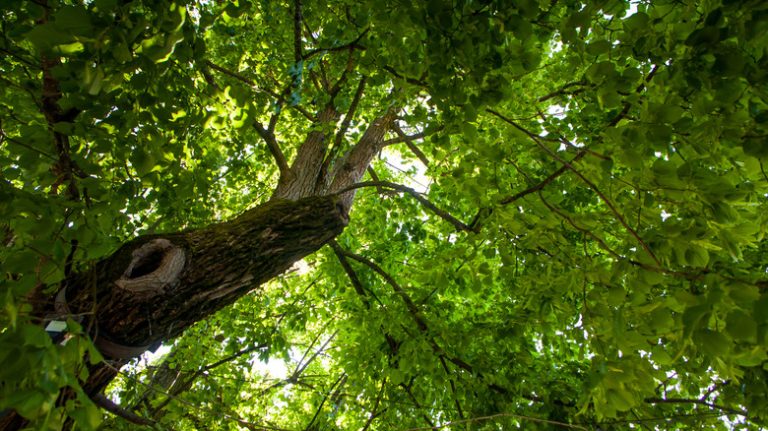Encountering trees wrapped in aluminum foil may seem unusual at first, but it serves practical purposes rather than fantastical ones, such as some desperate attempt to contact aliens. Instead, this method acts as an effective barrier against herbicides. In areas where chemical weed control is widespread—like agricultural lands, urban settings, and in the garden—non-target plants, including trees, risk significant exposure to these chemicals. Wrapping aluminum foil around the base of trees offers a protective measure, safeguarding them from accidental herbicide damage.
This is mainly due to herbicide drift, which occurs when pesticides intended for a specific target move through the air to unintended locations. It occurs primarily through droplet drift (when droplets of herbicide sprayed onto target plants are carried away by the wind to other areas) and vapor drift (when herbicides applied to plants or soil evaporate and turn into gases affecting nearby vegetation).
Trees, particularly young or fruit-bearing ones, can be highly susceptible to this damage, which includes leaf wilting, discoloration, stunted growth, and even death. The decision to use herbicides, even with the knowledge that they can adversely affect trees, is primarily influenced by the need to manage competing vegetation effectively. Unwanted plants and weeds can significantly out-compete young trees 9:1 for nutrients. In such scenarios, the competition can be so severe that the tree’s growth is stunted or the tree can even die prematurely. In essence, using herbicides is a balancing act, where aluminum foil can play a crucial role in mitigating risks.
How to apply aluminum foil to your tree

The success of using aluminum foil as a barrier against herbicides depends on its correct application. The foil should be wrapped tightly (but not too tight) around the base of the tree, covering a sufficient height to protect against spray drift and soil-borne herbicides. Properly overlapping the foil is crucial to eliminating any potential herbicide entry points. Extending the foil a few inches into the soil can protect against herbicides absorbed through the root zone. Depending on weather factors, the foil could last a few months if applied and maintained correctly. The foil can remain effective for a few months when used and maintained, considering weather conditions.
While using aluminum foil as a barrier offers a simple and cost-effective way to protect trees from herbicides, there are several considerations to keep in mind: Aluminum foil should be used temporarily, especially during periods of herbicide application. Extended use of aluminum foil on tree trunks may cause moisture entrapment against the bark, softening it. This can lead to fungal infections, rot, and increased vulnerability to animal damage upon removal.
However, if you’re thinking of trying this method out yourself, remember that while aluminum foil is a practical solution, it’s also essential to pursue broader strategies to reduce herbicide reliance. Integrated pest management (IPM) approaches, including mechanical weeding, organic mulches, and selective herbicide application, can lessen the need for such physical barriers.
Other reasons aluminum foil can be wrapped around a tree

NationalParkDiaries/Youtube
An alternative reason for a tree wrapped in aluminum foil might be pest control. Certain pests, such as rodents or insects, can harm trees by chewing on the bark, leaves, or roots, making them vulnerable to infections. The reflective surface of the aluminum foil can disorient and deter these pests from getting too close to the tree. It can also create a physical barrier preventing them from climbing the tree trunk.
In winter, another reason for wrapping a tree with aluminum foil might be the protection of trees from sunscald. Sunscald is a condition that affects the bark of trees due to fluctuating temperatures. The aluminum foil’s reflective surface helps deflect sunlight, keeping the bark temperature more consistent and preventing the activation of cells during the day. This protective measure can be especially beneficial for stopping the cracking and splitting of bark, which are common symptoms of sunscald.
It might also signify a unique method for controlling tree growth, effectively suppressing unwanted buds and branches. This selective technique is beneficial for directing a tree’s growth, whether for aesthetic shaping or preventing growth into problematic areas, such as near power lines. While it avoids the need for pruning or chemicals, caution is advised; prolonged light deprivation could harm the tree.
Lastly, in rare cases, such as one in California, you can see aluminum foil wrapped along the base of General Sherman (also known as the world’s largest tree), to protect the tree from wildfires.



